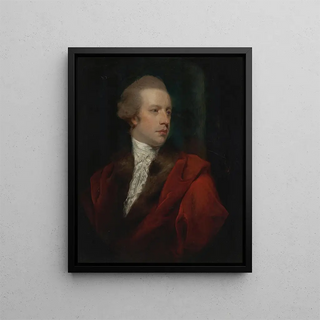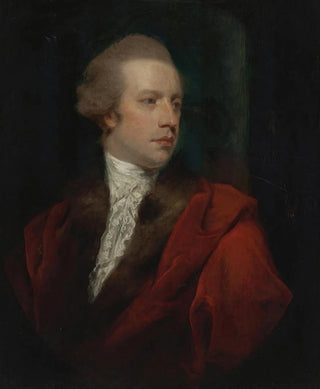Art print | Portrait of James Coutts Esquire - Sir Joshua Reynolds


View from behind

Frame (optional)
The "Portrait of James Coutts Esquire" by Sir Joshua Reynolds is an iconic 18th-century artwork, showcasing the painter's skill in capturing the personality and status of his subjects. Reynolds, a key figure in British portraiture, masterfully combines pictorial technique with a profound understanding of the human soul. This painting, in particular, not only exemplifies the refinement of his style but also illustrates how he immortalized a man of his time, James Coutts, whose image transcends eras. The soft light and rich colors emanating from this piece invite viewers to immerse themselves in a universe where past and present converge, offering a reflection on identity and celebrity.
Style and uniqueness of the work
Reynolds' style is distinguished by a blend of classical and innovative approaches. In this portrait, the composition is carefully orchestrated, with each element positioned to enhance the impression of dignity and respectability. The drapery, with its fluidity and texture, adds an almost tactile dimension to the artwork. The nuances of color, ranging from warm tones to delicate shadows, create an intimate atmosphere conducive to contemplation. This painting does more than depict a man; it tells a story, that of a man of letters and culture, at a time when social ascent was often symbolized through art. The way Reynolds plays with light and shadow accentuates Coutts' facial features, evoking a psychological depth reminiscent of the great masters of the Renaissance.
The artist and his influence
Sir Joshua Reynolds, born in 1723, is regarded as one of the greatest portraitists of his era. His career was marked by a desire to reform portraiture, integrating elements of historical painting and drawing inspiration from the great European masters. Reynolds founded the Royal Academy in 1768, where he encouraged many artists to explore new techniques and broaden their creative horizons. His influence extends beyond British borders, impacting generations of artists who saw in him a model of virtuosity and innovation. The "Portrait of

Matte finish

View from behind

Frame (optional)
The "Portrait of James Coutts Esquire" by Sir Joshua Reynolds is an iconic 18th-century artwork, showcasing the painter's skill in capturing the personality and status of his subjects. Reynolds, a key figure in British portraiture, masterfully combines pictorial technique with a profound understanding of the human soul. This painting, in particular, not only exemplifies the refinement of his style but also illustrates how he immortalized a man of his time, James Coutts, whose image transcends eras. The soft light and rich colors emanating from this piece invite viewers to immerse themselves in a universe where past and present converge, offering a reflection on identity and celebrity.
Style and uniqueness of the work
Reynolds' style is distinguished by a blend of classical and innovative approaches. In this portrait, the composition is carefully orchestrated, with each element positioned to enhance the impression of dignity and respectability. The drapery, with its fluidity and texture, adds an almost tactile dimension to the artwork. The nuances of color, ranging from warm tones to delicate shadows, create an intimate atmosphere conducive to contemplation. This painting does more than depict a man; it tells a story, that of a man of letters and culture, at a time when social ascent was often symbolized through art. The way Reynolds plays with light and shadow accentuates Coutts' facial features, evoking a psychological depth reminiscent of the great masters of the Renaissance.
The artist and his influence
Sir Joshua Reynolds, born in 1723, is regarded as one of the greatest portraitists of his era. His career was marked by a desire to reform portraiture, integrating elements of historical painting and drawing inspiration from the great European masters. Reynolds founded the Royal Academy in 1768, where he encouraged many artists to explore new techniques and broaden their creative horizons. His influence extends beyond British borders, impacting generations of artists who saw in him a model of virtuosity and innovation. The "Portrait of






